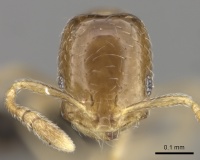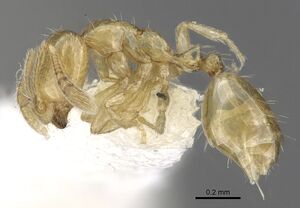Monomorium fastidium
| Monomorium fastidium | |
|---|---|

| |
| Scientific classification | |
| Kingdom: | Animalia |
| Phylum: | Arthropoda |
| Class: | Insecta |
| Order: | Hymenoptera |
| Family: | Formicidae |
| Subfamily: | Myrmicinae |
| Tribe: | Solenopsidini |
| Genus: | Monomorium |
| Species: | M. fastidium |
| Binomial name | |
| Monomorium fastidium Bolton, 1987 | |
The type material is listed as being found in eucalyptus litter. Many subsequent collections are from grassland habitats.
Identification
Bolton (1987f) - A member of the M. boerorum complex in the M. monomorium species group. A minute yellow species close to and slightly larger than Monomorium mictilis, but lacking the depressed head capsule of that species and having the promesonotum somewhat more convex. Apart from this the head in mictilis tends to be somewhat narrower (CI 72-76 as opposed to CI 76-79 in fastidium) and slightly different in shape. Whereas in fastidium the head in full-face view is broadest behind and narrows anteriorly, the head in mictilis is broadest immediately behind the eyes and gradually narrows both anteriorly and posteriorly from this point.
Keys including this Species
Distribution
Latitudinal Distribution Pattern
Latitudinal Range: -24.70099° to -34.47917°.
| North Temperate |
North Subtropical |
Tropical | South Subtropical |
South Temperate |
- Source: AntMaps
Distribution based on Regional Taxon Lists
Afrotropical Region: South Africa (type locality).
Distribution based on AntMaps
Distribution based on AntWeb specimens
Check data from AntWeb
Countries Occupied
| Number of countries occupied by this species based on AntWiki Regional Taxon Lists. In general, fewer countries occupied indicates a narrower range, while more countries indicates a more widespread species. |

|
Estimated Abundance
| Relative abundance based on number of AntMaps records per species (this species within the purple bar). Fewer records (to the left) indicates a less abundant/encountered species while more records (to the right) indicates more abundant/encountered species. |

|
Biology
Castes
Worker
Images from AntWeb
   
| |
| Paratype of Monomorium fastidium. Worker. Specimen code casent0902269. Photographer Ryan Perry, uploaded by California Academy of Sciences. | Owned by NHMUK, London, UK. |
Nomenclature
The following information is derived from Barry Bolton's Online Catalogue of the Ants of the World.
- fastidium. Monomorium fastidium Bolton, 1987: 389 (w.q.) SOUTH AFRICA.
- Type-material: holotype worker, 10 paratype workers, 5 paratype queens.
- Type-locality: holotype South Africa: E Cape Prov., Walmer, nr Port Elisabeth, 3.iii.1969, eucalypt litter, M374 (W.L. Brown); paratypes with same data.
- Type-depositories: MCZC (holotype); BMNH, MCZC (paratypes).
- Status as species: Bolton, 1995b: 261.
- Distribution: South Africa.
Unless otherwise noted the text for the remainder of this section is reported from the publication that includes the original description.
Description
Worker
Holotype. TL 1.4, HL 0.42, HW 0.33, CI 79, SL 0.27, SI 82, PW 0.20, AL 0.42.
Clypeal carinae distinctly developed, divergent anteriorly, reaching the anterior margin but not terminating in denticles or angular projections. In full-face view the median portion of the clypeus prominent and the anterior border of the prominence more or less transverse. Maximum diameter of eye 0.21 x HW. In profile the eye longer than high and consisting of an outer ring of ommatidia enclosing a single longitudinal row of only 3 ommatidia. In full-face view the eye conspicuously in front of the midlength of the sides of the head. Antennae with 11 segments. Antennal scapes, when laid straight back from their insertions, failing to reach the occipital margin. Head capsule in full-face view broadest posteriorly, the sides evenly and gradually narrowing anteriorly and the eyes situated in front of the broadest part of the head. In profile the ventral surface of the head convex, the convexity only shallow but noticeably greater than the convexity of the cephalic dorsum immediately behind eye-level. Promesonotum in profile not strongly convex, sloping very shallowly to the distinctly impressed and relatively broad metanotal groove; the latter with conspicuous cross-ribs. Propodeum highest immediately behind the metanotal groove then falling away posteriorly in an even, smoothly convex curve, without differentiation into dorsum and declivity. Propodeal spiracle minute and pinhole-like. Anterior peduncle of petiole short and stout, with a small lobulate ventral process. Petiole node with anterior face longer and somewhat more shallowly sloped than posterior face; the node narrowly but bluntly rounded above. Postpetiole smaller and slightly lower than petiole , much more broadly rounded dorsally. All dorsal surfaces of head and body with standing hairs, the promesonotum with only 3 pairs. Anterior margin of pronotum without a pair of standing hairs between those at the humeri. Unsculptured except for the metanotal cross-ribs. Colour uniform dull pale yellow.
Paratypes. TL 1.4, HL 0.42-0.43, HW 0.32-0.33, CI 76-79, SL 0.26-0.28, SI 81-85, PW 0.20-0.21, AL 0.42-0.44 (10 measured). As holotype but some paratypes have a fourth promesonotal pair of standing hairs.
Type Material
Holotype worker, South Africa: E. Cape Prov., Walmer nr Port Elizabeth, 3.iii.1969, eucalypt litter, M374 (W. L. Brown) (Museum of Comparative Zoology). Paratypes. 10 workers and 5 alate females with same data as holotype (MCZ; The Natural History Museum).
References
- Sparks, K. 2015. Australian Monomorium: Systematics and species delimitation with a focus of the M. rothsteini complex. Ph.D. thesis, University of Adelaide.
- Bolton, B. 1987. A review of the Solenopsis genus-group and revision of Afrotropical Monomorium Mayr (Hymenoptera: Formicidae). Bulletin of the British Museum (Natural History). Entomology. 54: 263-452.. (page 389, worker, queen described)
References based on Global Ant Biodiversity Informatics
- Bolton B. 1987. A review of the Solenopsis genus-group and revision of Afrotropical Monomorium Mayr (Hymenoptera: Formicidae). Bulletin of the British Museum (Natural History). Entomology 54: 263-452.

